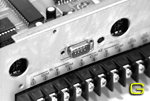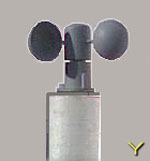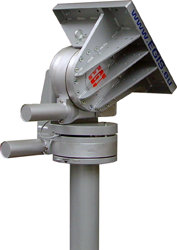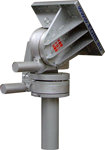|
O
|
 |
SOLAR-TRACKER XL
consisting of rotor and control box for the astronomical calculated tracking of objects conform to the sun-position, using Kepler data
- 90° elevation span
- 360° azimuth turn angle; endless
- comprising intelligent control box in 19” rack housing with 3 HE
- 40 digits LC-Display
- lots of dynamic operational information on the display:
- operational data
- time (clock)
- analog level available
- date
- AZ-angle
- EL-angle
- directions of run
- and more, and more …
- quartz-stable calendar clock
- programmable limit-angles
- battery backup memories
- auto start after blackout
Operated completely via front-sided pushbutton-field.
Functions in sequence: At the mechanical montage the rotor lines up only roughly in north/south direction. After going operational, only two parameters are to be inputted: the geographical coordinates of the built-up site (length and width) and the time/date (GMT/UT). The consideration of leap years, the calculation of the true local time and the sun coordinates are done full-automatically. A rearranging of the internal clock at the change from summer- to wintertime and vice versa is not necessary.
Aiming the sun directly: The rotor will – more or less – look beside the sun (the goal) due to mechanical montage errors. With 4 keys (UP/DOWN/EAST/WEST) could be driven on the sun optimum now easily. Ready! The tracker now follows the sun day by day – full-automatically. If the sun leaves your preset angle-area, the rotor waits in night-sleep-position up to the next day and begins the daily work in the right moment at the right position again.
The tracking behavior (tracking) can be influenced itself by selecting the allowable angle deviation and/or by time-axis selection of the next search cyclus, taking care of the motors.
Of course one could approach with such a system exquisitely any position manually: with a look on the display, heeding AZ and EL angles, steer up and down. Minimal step-size of 0.1°!
A technical characteristic of the tracker and contributing decisively to its preciseness and quality consists in the use of semi-conductor relays to operate the motors. A number of advantages and functionalities (mentioned below) result from this technical feature:
- no contact-burnout, due to mechanically contactless switching
- less noise due to absence of switching or cut-off sparks
- smooth, silent control unit, because no parts are moving
- cultivated servo-speed-operation, because semiconductors are switched on and off in high frequency
- more precisely, because different speeds can be driven with solid state switches
- improved tracking behavior, because the positions can be targeted more precisely by 'soft stopping' and 'soft starting' with reduced speed
The motors are upshifted softly and partly in two steps and slowed down very softly. By this dampened acceleration of masses motor, gear and bearing are less stressed and less abrasion wear occurs. Accuracy and lifetime are kept for a longer time.
Working with mirror (indirect tracking) selects the reflection mode. In this process the sun reflexion is moved to the selected goal with 4 keys (UP/DOWN/EAST/WEST). The present goal-vector will be calculated and stored internally. After this start tracking, the sun-vector now will be converted in accordance with the physical laws of reflection right into the mirror-position that the reflex of the sun always meets the goal-point determined by you. This is also performed day by day – full-automatically.
|
| DISPLAY-READOUT |
 |
 |
 |
| |
operation status |
|
mode |
|
time |
|
activity |
|
day cycle |
|
azimuth angle |
|
elevation angle |
|
| |
 |
|
 |
|
 |
|
 |
|
 |
|
 |
|
 |
|
 |
 |
| |
RUN |
|
M |
|
15:34:48 |
|
Go |
|
S |
|
AZ123.5 |
|
EL015.2 |
|
 |
 |
 |
 |
Systems which can be powered by low potential voltage (24 V) are also available.
|
 |
 |
The following functionality and equipment version may be particularly interesting for the area of sciences, research and teaching:
ANALOG-INPUT
This hard and firmware implementation allows to feed an extern analogous signal into the control box on the rear side. This signal is processed with 8 bit solution (0 until 255) and serves to the automatic position-optimization.
Typical uses are:
- a temperature dependent solar collector slaved control and/or optimization
- charge and voltage dependent photovoltaic panel tracking and/or optimization
- a light (lux) dependent position optimization of optical lenses/collectors
- concentrating solar optical as well as thermal systems
- and a good deal more!
The DC voltage demanded for these processes should be within the area between 0.2 until 12 Volt. The input impedance is around 250 kOhm. As well as positive indicated signals as well as reciprocal signals can be processed. The operational area of the measured signal can be adapted to the probe as well as in amplitude/slope as well as in setting zero (signal var. 0.1 V positive/negative). The sampling input clockrate is about 250 Hz!
By this procedure a signal performance never manageable by hand is achieved!
If desired, this signal values can be interrogated via the RS 232 C interface separately – or automatically/cyclically. By use of the keys of the control box an optimization process can be started anytime (or with the sequence of letters "FOCUS" via data-interface). The optimization and tracking behavior can be influenced motor-saving itself by programming of the admissible signal break level (threshold) by selection of the next test cycle timing, by determination of the signal amplitudes and by determination of the search algorithm. The pluggable connection cable to the probe is inclusive in delivery.
This functionality provides an automatic application of he light direction finding tube.
|
|
O

|
 |
PC-COMMUNICATION-INTERFACE
For communication with an external computer, the SolarTracker XL is equipped with a two way »RS 232 C data interface« (data stream: 8 bit / no parity / 1 stop-bit / 300 up to 76800 baud with/without hardware-handshake).
The direction determining information is given via 'RS 232 C' interface into the rotor-control. Likewise in opposing direction information can be loaded out of operational status. The intelligent interface allows operation via phone modem, too.
When working together with the option 'analog-interpretation', the system can be used for the analog signal controlled aligning and tracking of probe signals e. g. weather balloons. The measuring directions and the analog power values are transferred via the data interface onto the external computer permanently!
The communication between control box and external computer is managed in a kind of BASIC language, by which only the simple 7 bit ASCIl mode is used.
Command syntax examples:
- Turn azimuth-motor to 134.56° – "AZ = 134.56 [CR]" or
- Command computer elevation position – "EL = ? [CR]"
- Using the instruction-word "FOCUS" automatically starts a focussing-run.
-
Using the instruction "RESULT", after each auto-focussing the automatic output of operational and performance data is induced, e.&nsp;g. AZ- and EL-angle with corresponding field strength. These can be transferred to a computer (as a protocol for instance), but also onto a printer directly! These data can be stored on the computer's hard disk in a file and can be used in any commercially available spreadsheet program (MS Excel etc.) or in data bases and can be displayed graphically without a special program!
Date and time are additionally inserted into this data string. See a sample of this data string here:
Row-no.; day; date; time; tracking-channel; AZ-angle; EL-angle; AZ-motor-pulses; EL-motor-pulses; level of analog-channel 1; 3; 4 in the format as follows:
00000 Mon 11.12.98 15:23:44 01 00000 00000 00000 00000 00000 00000 00000.
There are more instructions available.
(Not all applications have yet been discovered. What's your idea: …?)
Already with any simple terminal program commands and responds can be managed via modem and wire!
This interface is also used for the functionality "GPS CAPTURE".
|
 |
 |
GPS-CAPTURE-FUNCTION
By this function you may take over global positioning data automatically from a GPS navigator/receiver via the serial interface into program-memory PRG 01 of the control unit. In this case it is no more necessary to enter the location data of the system manually.
The NMEA183 protocol with data set "GPRMC" will be used.
|
 |
 |
MOTION CONTROL
Hard- and firmware extension for the dynamic, controlled, dialog-oriented speed determination. You can select start acceleration, speed of silent service, maximum speed and break delay with high resolution. Especially meaningful for fine positioning and focussing of big objects/loads. Because of Soft-Start and Soft-Stop motor, gear and bearings are protected and positioning accuracy is longer preserved and the lifespan is extended. This extension is definitely needed for usage of the 'Heliostat' function (indirect tracking).
|
 |
 |
AZ360
The azimuth slewing-range allows for 360° continuous operation. This also includes extended firmware: it contains as well a turn counter with programmable limit (to prevent cable damage). This limit is settable by the user from 1 to 99 revolutions in each run-direction and is managed automatically.
|
|
O

|
 |
19"-RACK-HOUSING
For control centers and technical headquarters in weather observatories, universities, research laboratories and scientific institutes service and control often is demanded in 19" racks. This version includes a controller in a 19" rack housing with 3 HE x 290 mm with aluminum-colored front board is available. Additional to better EMC a pluggable wiring and an illuminated two-lined displays is included in the price. Likewise a frontsided security lock (2 keys) to lock definite operating functions is provided which secures the station against inadmissible operation. Accessory LEDs show run-directions and different operational status. Furthermore the device offers the possibility to operate the motor unit via an additional interface with lower or higher voltage/power (limited) too for speed-control and/or increased power. That surrenders also an advantageous separation of the power-supply of logic and power!
|
 |
 |
Useful additions:
|
|
O

|
 |
LIGHT DIRECTION FINDING TUBE
The light-direction/calibration tube allows the easy and comfortable finding of the direction/position with the maximum of light. It consists out of a inside matted tube with a sensor attached at the tube-base bottom. A 5 m long litz wire is connected solidly. Attached are a universal sensor-fix and mounting-material.
The tube carrier has to be mounted plane onto the object to be positioned, so that the direction finding tube stands perpendicular upright on the sight-plane. The direction finding device can be connected to any ohm-meter (multimeter) usual in the trade and serves in this application to manually align the rotor-head with the keys on the control-unit (UP/DOWN/EAST/WEST). A fully automatical position-optimization is possible along with the device-extension "ANALOG"-signal-input. Thereby signal-peaks are achieved, not manageable in manual operation. In the mode "AUTOFOCUS" – automatically – after each astronomical positioning an investigation for a better signal is originated. The results are displayed with a 8 bit word in the control-unit’s display and output via the serial interface together with other data, if needed.
|
|
O

|
 |
WIND SPEED SENSOR/SHELL ANEMOMETER
The Anemometer performs the measurement of the local appearing wind-speeds. The 4-wire-interface at the control unit is quite ready to read and process the signals from the anemometer.
Details:
- 3-shell-system
- shell ring outside-Ø: 120 mm
- shell-Ø: 40 mm
- profile: 70 mm
- material: ABS
- pulse transducer system: magnet/reed switch
- pulse-rate: 60 km/h = 16.8 m/sec. = 47 Hz
- suitable for mounting onto or besides the mast
|
|
|
The azimuth-elevation turning system consists of the rotor outdoor unit Solar Tracker XL as well as of the indoor unit XL. There are no additional parts necessary between 'mast' and 'panel/reflector/concentrator'.
The rotor outdoor unit moves the object to be positioned fully automatically and microprocessor controlled on single positions or on tracks. For this in the rotor-outside-part, made of a weatherproof cast, two separate 24 volts motors are installed.
These drive using corresponding mechanism, the reflector with a high precision and return-accuracy of 0.1° into the wished directions, that is done as well as in azimuth as also in elevation direction.
Due to the two completely separated drive motors there is no need of immediate calibrating each mechanical tracking path and by that the former necessary exact calibrations so as very time-extensively set-up works of azimuth, elevations, north-south-axis etc. can be done comfortably at the control box!
The u. m. azimuth elevation turning system moves the objects in a 360° (endless) azimuth area. In elevation range the system suffers an elevation of 95°. Where exactly this lifting is used is up to the user: if elevation angle 0° until 90° or 25° until –65°. In contrast to many a actuator motors, the system is doing this all very quietly, which goes without saying with such a system.
Technology of the Operation and Control Unit
The only adjustment during montage and installation of the rotor-outside-unit is rough northern-south-alignment of the housing. Only rough for the one reason that all eventually needed corrections can be done at the indoor unit. The operation and control unit is to be understood as a switching and computing center, the heart of the plant. The heart consists out of a quick 8-bit-microcontroller and allows the technicians under the users a real eldorado of programming. Already the assembler will be informed of incorrect or missing connections. So the control box contains e. g. an electronic blocking and overload protection, run direction supervision and related clear-text-information.
Functionalities and performance, which are of special interest for the operators and users of the system: There is e. g. the memory; all data and also the operational program is accommodated in read only memory imprescriptibly.
To manage simple and easy tracking out of the data in the computer-memory only two technical instructions are to be implemented into calculations, namely the last unknown that the system could not predict:
The location-coordinates of the rotor and time with date! After input of these values into the processor by means of keyboard the processor calculates the necessary azimuth and elevation angle of lineup-spot to each sun position in shortest time.
After this computing process you may start the 'tracking'. Due to mechanical montage errors you will aim more or less exact at the sun. However for this rotor deviations are no problem: with resp. keys meet directly the sun, all comfortable out of your armchair!
One of the most outstanding performance features of the system is its ability to cope with high wind speeds. You will instantly recognize the high durability and stiffness of the rotor steel-casing. However – what does the interior look like? Here some information for the technician concerning the construction of the rotor:
This correction causes the control computer to save the data of the now exactly gotten sun position and the previously already entered data for later use. Immediately after that you may switch to 'RUN' and the rotor will 'track' in good quality.
Comfortably and simple - is installation. However – how behaves the system in everyday-business? Via front keys of the control box comfortably correct east-west-deviations. Or you take full control over the whole system via the key field.
The comfort doesn’t cease, it has now just begun. The computer is able, thanks to his future-safe construction, to respect all locations no matter if western or eastern of Greenwich, northern or southern from equator. The u. m. calculations will be done always with the same accuracy. The rotor computer will calculate for each position on the earth in which angles the sun presently is to be expected!
One of the most outstanding performance features of the system is its ability to cope with high wind speeds. You will instantly recognize the high durability and stiffness of the rotor steel-casing. However, what does the interior look like? Here some information for the technician concerning the construction of the rotor:
- All used tooth-wheels are made out of steel!
- All used tooth-wheels are mill cut!
- The most important tooth-wheels are specially sediment-hardened!
- All mechanism-parts are selected for long lifetime and high accuracy.
- All parts – also in the rotor inside – have high corrosion-protection!
- LC-display (40 digits/one line)
- true angle-readings for AZ + EL
- Electronic mechanism-tolerance balance
- motor delay to-sprint
- selectable positioning-tolerance
- determination of fine step size
- determination of motor wait-state-time before new positioning
- automatic system-test
- passwords for system inputs
- analog-signal dependent (input voltage dependent) fine-positioning and tracking
- 360° azimuth turn range (endless turnaround)
- 90° elevation span (horizon to zenith)
- data interface to PC, modem or printer (RS 232 C)
- solid state relais
- GPS (Global-Positioning-System)-Software-Interface (NMEA183)
- controlled (SERVO) drive speed
- professional 19"-rack versions
- operates complete automatically, resumes operation automatically after power failure
- Integrated wind-sensor-interface. The wind-sensor-interface is provided to connect a pulse-output wind-anemometer with the 4-wire-interface. After setting 'pulse per unit of time' of the wind-sensor and after reaching the wind-speed trigger preset by the user, the unit turns into a more streamlining position also preset by the user (but only within the rotor's range of motion). The delay-time in this position can be preset, too.
All this can be found in the more detailed instructions and assembling manual, enclosed to each azimuth-elevation system.
show animation movie clip: animation movie clip of the SolarTracker XL (1 MB)
download link: data sheet of the SolarTracker XL (2.8 MB)
|
 |
 |
 |
OPERATIONAL COMPUTER: SolarTracker XL II |
 |
 |
 |
 |
 |
 |
 |
power supply |
 |
 |
223/115 Volt AC or 24 Volt DC |
 |
 |
 |
 |
 |
 |
 |
consumption |
 |
 |
16 VA standby; max. 130 VA |
 |
 |
 |
 |
 |
 |
 |
display and information |
 |
 |
LC-display |
 |
 |
 |
 |
 |
 |
 |
programmable memories |
 |
 |
64 KB RAM |
 |
 |
 |
 |
 |
 |
 |
motor-supply-voltage |
 |
 |
24 Volt DC |
 |
 |
 |
 |
 |
 |
 |
internal resolution: |
 |
azimuth |
 |
 |
0.01°/pulse |
 |
 |
 |
 |
 |
 |
| elevation |
 |
 |
0.01°/pulse |
 |
 |
 |
 |
 |
 |
 |
analogous signal range |
 |
 |
0.2 to 12 volt DC > 100 kOhm |
 |
 |
 |
 |
 |
 |
 |
analogous input clock rate/resolution/b> |
 |
 |
about 250 Hz |
 |
 |
 |
 |
 |
 |
 |
temperature limits: |
 |
operational |
 |
 |
–5 °C to +40 °C |
 |
 |
 |
 |
 |
 |
| survive & storage |
 |
 |
–15 °C to +60 °C |
 |
 |
 |
 |
 |
 |
ROTOR: SolarTracker XL II |
 |
 |
 |
 |
 |
 |
 |
special attributes |
 |
 |
2 separate motors for azimuth and elevation-movements |
 |
 |
 |
 |
 |
 |
 |
motor voltage |
 |
 |
24 Volt DC |
 |
 |
 |
 |
 |
 |
 |
power supply consumption |
 |
 |
100 watts maximum |
 |
 |
 |
 |
 |
 |
 |
'control device to rotor' cable |
 |
 |
10 x 0,6 mm2 screened (telephone cable proven!) |
 |
 |
 |
 |
 |
At version "SolarTracker Pro" these 10 wires are individually shielded. |
 |
 |
 |
 |
 |
4 × 1,5 mm2 (for motor power supply) |
 |
 |
| at lengths over 50 m 2.5 mm2 |
 |
 |
 |
 |
 |
 |
control-type |
 |
 |
teeth gears |
 |
 |
 |
 |
 |
 |
 |
maximal azimuth turn range |
 |
 |
360° (endless) |
 |
 |
 |
 |
 |
 |
 |
maximal elevation range |
 |
 |
90° |
 |
 |
 |
 |
 |
 |
 |
return accuracy (part load) |
 |
 |
0.1° |
 |
 |
 |
 |
 |
 |
 |
tracking resolution |
 |
 |
< 0.1° |
 |
 |
 |
 |
 |
 |
 |
 |
 |
speed: |
 |
azimuth |
 |
 |
approx. 1°/sec. |
 |
 |
 |
 |
 |
 |
| elevation |
 |
 |
approx. 1°/sec. |
 |
 |
 |
 |
 |
 |
 |
usable payload |
 |
 |
500 kg |
 |
 |
 |
 |
 |
 |
 |
casing |
 |
 |
steel, protected against negative climatic effects |
 |
 |
 |
 |
 |
 |
 |
dimensions: |
 |
diameter |
 |
 |
approx. 70 cm |
 |
 |
 |
 |
 |
 |
| height |
 |
 |
approx. 75 cm |
 |
 |
 |
 |
 |
 |
Click here to see a dimensional sketching! |
 |
 |
 |
 |
 |
 |
 |
weight |
 |
 |
about 300 kg |
 |
 |
 |
 |
 |
 |
 |
transport package |
 |
 |
on euro pallet 1,4 × 0,8 m; about 80 cm in height |
 |
 |
 |
 |
 |
 |
 |
mechanical connections: |
 |
reflector |
 |
 |
see dimensional sketching |
 |
 |
 |
 |
 |
 |
| mast |
 |
 |
see dimensional sketching |
 |
 |
 |
 |
 |
 |
 |
maximal reflector size |
 |
 |
12 m2 |
 |
 |
 |
 |
 |
 |
 |
maximale Windgeschwindigkeiten |
 |
 |
70 km/h in operation, |
 |
 |
| up to 180 km/h with a panel size of 12 m2! |
 |
 |
 |
 |
 |
 |
temperature limits: |
 |
operational |
 |
 |
–20 °C to +60 °C |
 |
 |
 |
 |
 |
 |
| survive & storage |
 |
 |
–30 °C to +65 °C |
 |
 |
 |
 |
 |
 |
 |
 |
 |
 |
 |
 |
 |
 |
 |
 |
VERSION |
 |
| (inclusive 19 % VAT) EURO |
 |
 |
 |
 |
 |
 |
 |
 |
SolarTracker XL |
 |
 |
Rotor inclusive of control box |
 |
 |
price on inquiry |
 |
 |
 |
 |
 |
 |
 |
 |
 |
 |
 |
 |
 |
 |
 |
 |
 |
OPTIONS |
 |
| (inclusive 19 % VAT) EURO |
 |
 |
 |
 |
 |
 |
 |
 |
light direction finding tube |
 |
 |
light-sensor for measuring, calibration and optimization purposes |
 |
 |
449.82 |
 |
 |
 |
 |
 |
 |
 |
 |
 |
Wi-S1 |
 |
 |
wind-speed-sensor/shell-anemometer |
 |
 |
377.65 |
 |
 |
 |
 |
Please contact us for your special application!
Technical improvements are subject to change!
|

|
E G I S
EQUIPMENT GESELLSCHAFT für
INTERN. ELEKTRONIK SYSTEME GmbH
|
Flutstraße 34 – 36
D–63071 OFFENBACH/MAIN
Tel.: 069 / 85 83 27
Fax: 069 / 85 78 63
|
| << Homepage |
20 minutes from Airport Frankfurt – 20 minutes to Frankfurt City |
E-Mail: Solar@egis.eu |
Top
|






